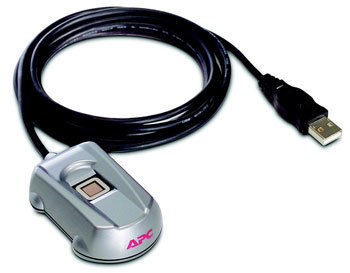|
Your finger is your password: Computer Security
Tim J. Summers
 Ma Bell used to say “let your fingers do the walking”. Now your fingers can make your computer more secure. This Biometric Biopod security device by APC just needs a simple set up and a scan of any one of your 20 digits. That’s right. If you are tidy, use your big toe and scan it right into the secure vault. The illustration says it all - there is a PCard model for laptops. Store up to 20 digits and any one of those will have access to the system. Ma Bell used to say “let your fingers do the walking”. Now your fingers can make your computer more secure. This Biometric Biopod security device by APC just needs a simple set up and a scan of any one of your 20 digits. That’s right. If you are tidy, use your big toe and scan it right into the secure vault. The illustration says it all - there is a PCard model for laptops. Store up to 20 digits and any one of those will have access to the system.
There is, however, a “master finger”. You won’t need to keep lists of passwords because your finger is your password. Oh yes, it is easy to switch between users with WinXP.
What will it cost? Less than $50. This is a good, basic device that provides tight security. And it is a better, more secure device. This Biopod is one of a genre that is fingerprint oriented and does not use body heat to further verify authorization.
Whenever the Biopod detects a program’s request for name/password, it will pop up and ask for your Biopod name/password. DO NOT forget the name and password. This program is very unforgiving. Your fingerprint can easily be verified, even if you cut it (as in scratch, not off!). I simulated this with a bit of duct tape.
It is a good-looking, small device with a 6’ USB cable. For a new, authorized user, use the “Omni-pass Enrollment Wizard” and simply click on “Add new user”, then follow the four simple steps. Start by entering user name and password. Next, and this seems a bit creepy, select a finger that will be your password and continue. I would suggest you take advantage of the practice feature. Press too hard and it won’t “take”.
Biopod uses special, security software by OmniPass. Computer users normally have to identify themselves to gain access in several different places: logging onto Windows; password-protected screen saver; e-mail login and web site logins.
OmniPass detects password fields in the programs, identifies the context, searches the Password Vault for remembered input and can automatically fill in the password for you. With OmniPass, you have a single master password that is used to “replace” all other passwords.
The first time a password-secured website or application is used, you simply enter the original password and then tell OmniPass to “remember that password.” From that point forward, anytime that website or application is used again, OmniPass remembers.
Example: Jay Jones installs OmniPass on his system and creates a new user with the username of JayJay and a password of homefone. He logs onto his Yahoo mail account. He can type in his Yahoo username and password and ask OmniPass to remember the logon. From that moment on, when he goes to the Yahoo mail, OmniPass will recognize the site and prompt him to put in his username and master password. He types in JayJay and homefone into the OmniPass box and he now has access to his Yahoo mail account. Jay can repeat the process with other websites and programs using his master password. The master password doesn’t change, so it’s real simple.
There’s a separate OmniPass menu to add/remove names and a tab for Vault where passwords are stored and access is limited. For the price and performance, this device is superior for ease of use. Laptop users should pay special attention - you can remove the device. Put it in your pocket and no one can access your laptop. For more info and updates go to www.apc.com.
Tim J. Summers is a HAL-PC member who is the "go to guy" for wireless at a locally headquartered data security company. He installed their WiFi system two years ago.
Parental note: got a precocious child who can hack into any program, find any password and go to any web site? Forget your password list and use this fingerprint device. You can only go where the finger will take you. Note to precocious kids: don’t send me nasty e-mails. I was forced to write this by alien parents from Mars. Reviews Editor
|

